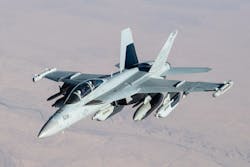Navy chooses Boeing to integrate and upgrade electronic warfare (EW) avionics systems on EA-18G combat jets
PATUXENT RIVER NAS, Md. – U.S. Navy aerial electronic warfare (EW) experts needed a company to upgrade the EW attack system aboard the EA-18G Growler carrier-based EW jet. They found their solution from the Boeing Co. Defense, Space & Security segment in St. Louis.
Officials of the Naval Air Systems Command at Patuxent River Naval Air Station, Md., announced plans in February to award a sole-source delivery order to Boeing for the Growler Block II Phase I Next Generation Electronic Attack (NGEAU) program.
Growler Block II is spiral upgrade to enable incremental capability improvements to regain an advantage in the electromagnetic spectrum until the EA-18G replacement aircraft is chosen in the future. The value of the contract to Boeing has yet to be negotiated.
The EA-18G Growler avionics suite carries the ALQ-218 receiver, ALQ-99 tactical jamming pods, ALQ-227 communication countermeasures set, and Joint Tactical Terminal – Receiver (JTT-R) satellite communications. The AN/ALQ-249 next generation jamming pod is in final development and will be the successor for the long serving ALQ-99 pods.
The ALQ-218 airborne electronic attack systems enhancement (ASE) is a combination hardware and software upgrade that enables the transition to Growler Block II. The NGEAU will enhance the EA-18G's ability to process and respond to unknown signals autonomously in a dense RF and microwave environment.
The AN/ALQ-218 from the Northrop Grumman Mission Systems segment in Baltimore is a passive sensor system that functions as a radar warning receiver, electronic support measures, and electronic intelligence.
The system provides airborne situational awareness and signals intelligence (SIGINT) by detecting, identifying, locating, and analyzing sources of radio frequency (RF) emissions.
The AN/ALQ-218 is aboard the EA-18G jet and the P-8A Poseidon maritime patrol aircraft, and is being considered in the future for unmanned aerial vehicles (UAVs) and submarines.
The AN/ALQ-218 can operate on RF bands 0, 1, 2, and band 3, with pulsed and continuous-wave radar with optional communications support, while providing specific emitter identification. It offers enhanced fine frequency measurement to support electronic jamming.
Boeing is the sole designer, developer, and manufacturer of the EA-18G aircraft in its various configurations and is the only source with the manufacturing knowledge, experience, and technical data necessary to integrate the AN/ALQ-218 aboard the Growler aircraft. The period of performance for this effort is to be 31 months.
Contact Boeing for small business or subcontracting opportunities on the NGEAU program online at www.boeingsuppliers.com/esd/getstart.html.
For more information contact Boeing Defense, Space & Security online at www.boeing.com/company/about-bds, or Naval Air Systems Command at www.navair.navy.mil.
About the Author
John Keller
Editor-in-Chief
John Keller is the Editor-in-Chief, Military & Aerospace Electronics Magazine--provides extensive coverage and analysis of enabling electronics and optoelectronic technologies in military, space and commercial aviation applications. John has been a member of the Military & Aerospace Electronics staff since 1989 and chief editor since 1995.
